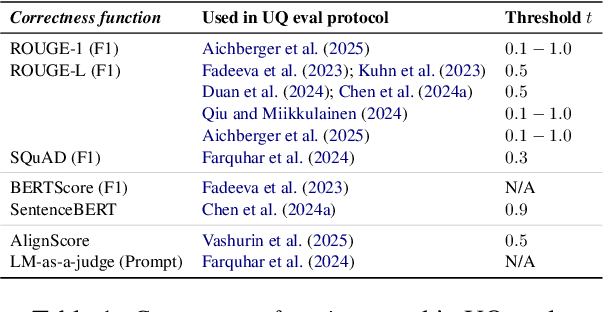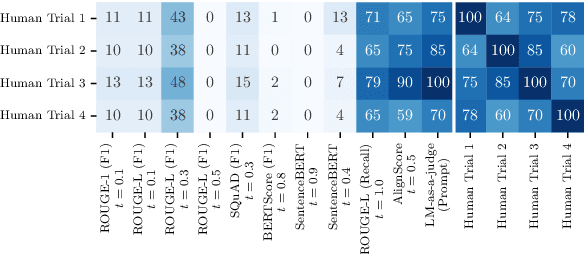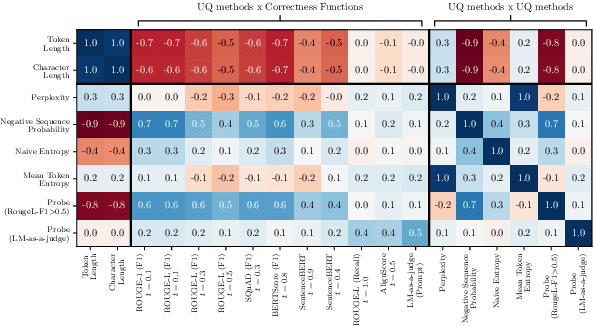Michael Kirchhof
Michael Pokorny
Trained on Tokens, Calibrated on Concepts: The Emergence of Semantic Calibration in LLMs
Nov 06, 2025Abstract:Large Language Models (LLMs) often lack meaningful confidence estimates for their outputs. While base LLMs are known to exhibit next-token calibration, it remains unclear whether they can assess confidence in the actual meaning of their responses beyond the token level. We find that, when using a certain sampling-based notion of semantic calibration, base LLMs are remarkably well-calibrated: they can meaningfully assess confidence in open-domain question-answering tasks, despite not being explicitly trained to do so. Our main theoretical contribution establishes a mechanism for why semantic calibration emerges as a byproduct of next-token prediction, leveraging a recent connection between calibration and local loss optimality. The theory relies on a general definition of "B-calibration," which is a notion of calibration parameterized by a choice of equivalence classes (semantic or otherwise). This theoretical mechanism leads to a testable prediction: base LLMs will be semantically calibrated when they can easily predict their own distribution over semantic answer classes before generating a response. We state three implications of this prediction, which we validate through experiments: (1) Base LLMs are semantically calibrated across question-answering tasks, (2) RL instruction-tuning systematically breaks this calibration, and (3) chain-of-thought reasoning breaks calibration. To our knowledge, our work provides the first principled explanation of when and why semantic calibration emerges in LLMs.
BED-LLM: Intelligent Information Gathering with LLMs and Bayesian Experimental Design
Aug 28, 2025Abstract:We propose a general-purpose approach for improving the ability of Large Language Models (LLMs) to intelligently and adaptively gather information from a user or other external source using the framework of sequential Bayesian experimental design (BED). This enables LLMs to act as effective multi-turn conversational agents and interactively interface with external environments. Our approach, which we call BED-LLM (Bayesian Experimental Design with Large Language Models), is based on iteratively choosing questions or queries that maximize the expected information gain (EIG) about the task of interest given the responses gathered previously. We show how this EIG can be formulated in a principled way using a probabilistic model derived from the LLM's belief distribution and provide detailed insights into key decisions in its construction. Further key to the success of BED-LLM are a number of specific innovations, such as a carefully designed estimator for the EIG, not solely relying on in-context updates for conditioning on previous responses, and a targeted strategy for proposing candidate queries. We find that BED-LLM achieves substantial gains in performance across a wide range of tests based on the 20-questions game and using the LLM to actively infer user preferences, compared to direct prompting of the LLM and other adaptive design strategies.
The Geometries of Truth Are Orthogonal Across Tasks
Jun 10, 2025Abstract:Large Language Models (LLMs) have demonstrated impressive generalization capabilities across various tasks, but their claim to practical relevance is still mired by concerns on their reliability. Recent works have proposed examining the activations produced by an LLM at inference time to assess whether its answer to a question is correct. Some works claim that a "geometry of truth" can be learned from examples, in the sense that the activations that generate correct answers can be distinguished from those leading to mistakes with a linear classifier. In this work, we underline a limitation of these approaches: we observe that these "geometries of truth" are intrinsically task-dependent and fail to transfer across tasks. More precisely, we show that linear classifiers trained across distinct tasks share little similarity and, when trained with sparsity-enforcing regularizers, have almost disjoint supports. We show that more sophisticated approaches (e.g., using mixtures of probes and tasks) fail to overcome this limitation, likely because activation vectors commonly used to classify answers form clearly separated clusters when examined across tasks.
Position: Uncertainty Quantification Needs Reassessment for Large-language Model Agents
May 28, 2025Abstract:Large-language models (LLMs) and chatbot agents are known to provide wrong outputs at times, and it was recently found that this can never be fully prevented. Hence, uncertainty quantification plays a crucial role, aiming to quantify the level of ambiguity in either one overall number or two numbers for aleatoric and epistemic uncertainty. This position paper argues that this traditional dichotomy of uncertainties is too limited for the open and interactive setup that LLM agents operate in when communicating with a user, and that we need to research avenues that enrich uncertainties in this novel scenario. We review the literature and find that popular definitions of aleatoric and epistemic uncertainties directly contradict each other and lose their meaning in interactive LLM agent settings. Hence, we propose three novel research directions that focus on uncertainties in such human-computer interactions: Underspecification uncertainties, for when users do not provide all information or define the exact task at the first go, interactive learning, to ask follow-up questions and reduce the uncertainty about the current context, and output uncertainties, to utilize the rich language and speech space to express uncertainties as more than mere numbers. We expect that these new ways of dealing with and communicating uncertainties will lead to LLM agent interactions that are more transparent, trustworthy, and intuitive.
Self-reflective Uncertainties: Do LLMs Know Their Internal Answer Distribution?
May 26, 2025Abstract:To reveal when a large language model (LLM) is uncertain about a response, uncertainty quantification commonly produces percentage numbers along with the output. But is this all we can do? We argue that in the output space of LLMs, the space of strings, exist strings expressive enough to summarize the distribution over output strings the LLM deems possible. We lay a foundation for this new avenue of uncertainty explication and present SelfReflect, a theoretically-motivated metric to assess how faithfully a string summarizes an LLM's internal answer distribution. We show that SelfReflect is able to discriminate even subtle differences of candidate summary strings and that it aligns with human judgement, outperforming alternative metrics such as LLM judges and embedding comparisons. With SelfReflect, we investigate a number of self-summarization methods and find that even state-of-the-art reasoning models struggle to explicate their internal uncertainty. But we find that faithful summarizations can be generated by sampling and summarizing. Our metric enables future works towards this universal form of LLM uncertainties.
Revisiting Uncertainty Quantification Evaluation in Language Models: Spurious Interactions with Response Length Bias Results
Apr 18, 2025



Abstract:Uncertainty Quantification (UQ) in Language Models (LMs) is crucial for improving their safety and reliability. Evaluations often use performance metrics like AUROC to assess how well UQ methods (e.g., negative sequence probabilities) correlate with task correctness functions (e.g., ROUGE-L). In this paper, we show that commonly used correctness functions bias UQ evaluations by inflating the performance of certain UQ methods. We evaluate 7 correctness functions -- from lexical-based and embedding-based metrics to LLM-as-a-judge approaches -- across 4 datasets x 4 models x 6 UQ methods. Our analysis reveals that length biases in the errors of these correctness functions distort UQ assessments by interacting with length biases in UQ methods. We identify LLM-as-a-judge approaches as among the least length-biased choices and hence a potential solution to mitigate these biases.
Humanity's Last Exam
Jan 24, 2025Abstract:Benchmarks are important tools for tracking the rapid advancements in large language model (LLM) capabilities. However, benchmarks are not keeping pace in difficulty: LLMs now achieve over 90\% accuracy on popular benchmarks like MMLU, limiting informed measurement of state-of-the-art LLM capabilities. In response, we introduce Humanity's Last Exam (HLE), a multi-modal benchmark at the frontier of human knowledge, designed to be the final closed-ended academic benchmark of its kind with broad subject coverage. HLE consists of 3,000 questions across dozens of subjects, including mathematics, humanities, and the natural sciences. HLE is developed globally by subject-matter experts and consists of multiple-choice and short-answer questions suitable for automated grading. Each question has a known solution that is unambiguous and easily verifiable, but cannot be quickly answered via internet retrieval. State-of-the-art LLMs demonstrate low accuracy and calibration on HLE, highlighting a significant gap between current LLM capabilities and the expert human frontier on closed-ended academic questions. To inform research and policymaking upon a clear understanding of model capabilities, we publicly release HLE at https://lastexam.ai.
Sparse Repellency for Shielded Generation in Text-to-image Diffusion Models
Oct 10, 2024Abstract:The increased adoption of diffusion models in text-to-image generation has triggered concerns on their reliability. Such models are now closely scrutinized under the lens of various metrics, notably calibration, fairness, or compute efficiency. We focus in this work on two issues that arise when deploying these models: a lack of diversity when prompting images, and a tendency to recreate images from the training set. To solve both problems, we propose a method that coaxes the sampled trajectories of pretrained diffusion models to land on images that fall outside of a reference set. We achieve this by adding repellency terms to the diffusion SDE throughout the generation trajectory, which are triggered whenever the path is expected to land too closely to an image in the shielded reference set. Our method is sparse in the sense that these repellency terms are zero and inactive most of the time, and even more so towards the end of the generation trajectory. Our method, named SPELL for sparse repellency, can be used either with a static reference set that contains protected images, or dynamically, by updating the set at each timestep with the expected images concurrently generated within a batch. We show that adding SPELL to popular diffusion models improves their diversity while impacting their FID only marginally, and performs comparatively better than other recent training-free diversity methods. We also demonstrate how SPELL can ensure a shielded generation away from a very large set of protected images by considering all 1.2M images from ImageNet as the protected set.
Uncertainties of Latent Representations in Computer Vision
Aug 26, 2024Abstract:Uncertainty quantification is a key pillar of trustworthy machine learning. It enables safe reactions under unsafe inputs, like predicting only when the machine learning model detects sufficient evidence, discarding anomalous data, or emitting warnings when an error is likely to be inbound. This is particularly crucial in safety-critical areas like medical image classification or self-driving cars. Despite the plethora of proposed uncertainty quantification methods achieving increasingly higher scores on performance benchmarks, uncertainty estimates are often shied away from in practice. Many machine learning projects start from pretrained latent representations that come without uncertainty estimates. Uncertainties would need to be trained by practitioners on their own, which is notoriously difficult and resource-intense. This thesis makes uncertainty estimates easily accessible by adding them to the latent representation vectors of pretrained computer vision models. Besides proposing approaches rooted in probability and decision theory, such as Monte-Carlo InfoNCE (MCInfoNCE) and loss prediction, we delve into both theoretical and empirical questions. We show that these unobservable uncertainties about unobservable latent representations are indeed provably correct. We also provide an uncertainty-aware representation learning (URL) benchmark to compare these unobservables against observable ground-truths. Finally, we compile our findings to pretrain lightweight representation uncertainties on large-scale computer vision models that transfer to unseen datasets in a zero-shot manner. Our findings do not only advance the current theoretical understanding of uncertainties over latent variables, but also facilitate the access to uncertainty quantification for future researchers inside and outside the field, enabling straightforward but trustworthy machine learning.
Benchmarking Uncertainty Disentanglement: Specialized Uncertainties for Specialized Tasks
Feb 29, 2024



Abstract:Uncertainty quantification, once a singular task, has evolved into a spectrum of tasks, including abstained prediction, out-of-distribution detection, and aleatoric uncertainty quantification. The latest goal is disentanglement: the construction of multiple estimators that are each tailored to one and only one task. Hence, there is a plethora of recent advances with different intentions - that often entirely deviate from practical behavior. This paper conducts a comprehensive evaluation of numerous uncertainty estimators across diverse tasks on ImageNet. We find that, despite promising theoretical endeavors, disentanglement is not yet achieved in practice. Additionally, we reveal which uncertainty estimators excel at which specific tasks, providing insights for practitioners and guiding future research toward task-centric and disentangled uncertainty estimation methods. Our code is available at https://github.com/bmucsanyi/bud.
 Add to Chrome
Add to Chrome Add to Firefox
Add to Firefox Add to Edge
Add to Edge